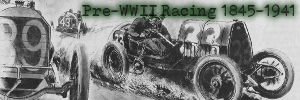|
By accessing or using The Crittenden Automotive Library™/CarsAndRacingStuff.com, you signify your agreement with the Terms of Use on our Legal Information page. Our Privacy Policy is also available there. |

Grand Prize
|
|---|
|
|
Grand Prize
Event
A series of road races sanctioned by the
AAA in 1908, 1911, 1912, 1914, 1915, and 1916. Events were held on road locations near Savannah, Milwaukee, Santa Monica, and San Francisco.
As Grand Prix is French for Grand Prize, the 1908-1916 Grand Prize events are considered the spiritual successor to the United States Grand Prix despite the lack of connections to the pre-F1 European grand prix circuit.
History
The following section is an excerpt from Wikipedia's United States Grand Prix page on 20 March 2021, text available via the Creative Commons Attribution-ShareAlike 3.0 Unported License.
The Savannah Automobile Club laid out a lengthened version of their stock car course, totaling 25.13 mi (40.44 km). Georgia Governor M. Hoke Smith authorized the use of convict labor to construct the circuit of oiled gravel. The Governor also sent state militia troops to augment local police patrols in keeping the crowd in check, hoping to avoid the pitfalls of the Vanderbilt Cup races. The entry for the inaugural race featured 14 European and six American entries, including factory teams from Benz, Fiat, and Renault. In the race, held on Thanksgiving Day, Ralph DePalma led early in his Fiat, before falling back with lubrication and tire problems. The race came down to a three-way battle between the Benz of Victor Hémery and the Fiats of Louis Wagner and Felice Nazzaro. Wagner won the race by the close margin of 56 seconds.
Despite the success of the Savannah event, it was decided that the 1909 race would be held on Long Island, in conjunction with the Vanderbilt Cup. However, only the Vanderbilt race was held and the Grand Prize pushed back to the next year. After the 1910 Vanderbilt Cup saw more issues, including the deaths of two riding mechanics and several serious spectator injuries, the Grand Prize was cancelled once again. A last-minute request by the Savannah club saved the race for the year, but only gave one month to prepare the course. A shorter 17-mile (27 km) course was laid out, but due to the short notice, most European teams were not able to make the trip. The leading trio from 1908 did make it and American David Bruce-Brown joined the Benz squad. Bruce-Brown won another incredibly tight race over teammate Hémery, this time by only 1.42 seconds. The 1911 event returned to Savannah, and this time the Vanderbilt Cup came with it; the Cup and Grand Prize were to be held together until 1916. Despite the success of the events, public pressure started to mount on the organizers. The use of convict labor and the militia drew criticism, as did the nuisance of closing roads for the event. Two accidents on the open roads in practice, one resulting in the death of Jay McNay, cast a shadow over the event. The American entries dominated the support events and ran well throughout the Grand Prize, after poor showings in past years and once again Bruce-Brown triumphed, this time driving a Fiat.
For 1912, Savannah succumbed to public pressure, and Milwaukee, Wisconsin, won the bid for the race. A narrow, 7.88-mile (12.68 km) trapezoidal course was set up on the outskirts of the city, in Wauwatosa. As in 1911, tragedy struck in practice when David Bruce-Brown was killed after a puncture sent him off the road. On the final lap of the race, Ralph DePalma collided with eventual winner Caleb Bragg, seriously injuring DePalma and his mechanic and ending any chance of a second race at Milwaukee.
The Grand Prize was not held in 1913, after Long Island's bid was rejected and Savannah refused to provide sufficient prize money. Oval racing on board tracks had taken off in the United States, to the detriment of road racing. For 1914, the Grand Prize and Vanderbilt Cup were staged in Santa Monica, California near Los Angeles, on an 8.4-mile (13.5 km) course, with the start/finish straight along the Pacific Ocean. The field was primarily American entries (twelve, against five European entries), and the Americans dominated, with Eddie Pullen's Mercer winning by over 40 seconds. In 1915, the race shifted to San Francisco, in conjunction with the Panama–Pacific International Exposition. With the outbreak of World War I in Europe, almost all of the drivers and cars were American, except for a few cars imported earlier. The 3.84-mile (6.18 km) course was set up around the Exposition grounds and nearby oval track with a boarded main straightaway. Heavy rain began two hours into the race, covering the circuit in mud from the extensive flower arrangements, and warping the main straight's boards. Dario Resta in a Peugeot cruised to a seven-minute victory, and followed up a week later by winning the Vanderbilt Cup. For 1916, the Grand Prize returned to Santa Monica. The race would be a part of the AAA National Championship, which carried a 4.91-liter displacement limit. Although the limit for the Grand Prize was 7.37 liters, no large-displacement cars would enter. The race was the penultimate round of the championship, with Dario Resta leading Johnny Aitken after his Vanderbilt Cup win. However, both cars would be out before halfway. Although Aitken took over teammate Howdy Wilcox's car for the win, the AAA awarded points only to Wilcox, and Resta took the championship.
The Grand Prize was discontinued after the 1916 event. Between a lack of European participation due to World War I and the growing American interest in oval racing, road racing fell by the wayside. The two Santa Monica events were the only road races on the 1916 championship, and the aborted 1917 National Championship was slated to feature 8 events, all ovals and six of them board tracks.
Article Index


















